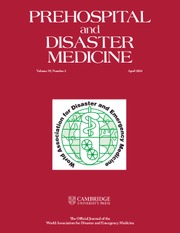Article contents
A Novel Algorithm for Improving the Diagnostic Accuracy of Prehospital ST-Elevation Myocardial Infarction
Published online by Cambridge University Press: 11 September 2019
Abstract
ST-segment elevation myocardial infarction (STEMI) is a time-sensitive entity that has been shown to benefit from prehospital diagnosis by electrocardiogram (ECG). Current computer algorithms with binary decision making are not accurate enough to be relied on for cardiac catheterization lab (CCL) activation.
An algorithmic approach is proposed to stratify binary STEMI computerized ECG interpretations into low, intermediate, and high STEMI probability tiers.
Based on previous literature, a four-criteria algorithm was developed to rule out/in common causes of prehospital STEMI false-positive computer interpretations: heart rate, QRS width, ST elevation criteria, and artifact. Prehospital STEMI cases were prospectively collected at a single academic center in Salt Lake City, Utah (USA) from May 2012 through October 2013. The prehospital ECGs were applied to the algorithm and compared against activation of the CCL by an emergency department (ED) physician as the outcome of interest. In addition to calculating test characteristics, linear regression was used to look for an association between number of criteria used and accuracy, and logistic regression was used to test if any single criterion performed better than another.
There were 63 ECGs available for review, 39 high probability and 24 intermediate probability. The high probability STEMI tier had excellent test characteristics for ruling in STEMI when all four criteria were used, specificity 1.00 (95% CI, 0.59-1.00), positive predictive value 1.00 (0.91-1.00). Linear regression showed a strong correlation demonstrating that false-positives increased as fewer criteria were used (adjusted r-square 0.51; P <.01). Logistic regression showed no significant predictive value for any one criterion over another (P = .80). Limiting physician overread to the intermediate tier only would reduce the number of ECGs requiring physician overread by a factor of 0.62 (95% CI, 0.48-0.75; P <.01).
Prehospital STEMI ECGs can be accurately stratified to high, intermediate, and low probabilities for STEMI using the four criteria. While additional study is required, using this tiered algorithmic approach in prehospital ECGs could lead to changes in CCL activation and decreased requirements for physician overread. This may have significant clinical and quality implications.
- Type
- Original Research
- Information
- Copyright
- © World Association for Disaster and Emergency Medicine 2019
References
- 2
- Cited by


